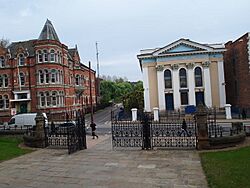Shakespeare Street Wesleyan Reform Chapel facts for kids
Quick facts for kids Shakespeare Street Wesleyan Reform Chapel |
|
|---|---|

Former chapel and former synagogue,
now university hall, on the right, in 2012 |
|
| 52°57′27″N 1°09′08″W / 52.957497°N 1.152205°W | |
| OS grid reference | SK 57064 40406 |
| Location | Shakespeare Street, Nottingham, England NG1 4FQ |
| Country | England |
| Denomination | Wesleyan Methodist |
| History | |
| Status | |
| Architecture | |
| Functional status | Closed; repurposed |
| Architect(s) | Thomas Simpson |
| Completed | 1854 |
| Closed | 1953 |
The Shakespeare Street Wesleyan Reform Chapel is a historic building in Nottingham, England. It started as a church for the Wesleyan Reform group. Over time, this building changed its purpose.
In 1953, it became a synagogue, a place of worship for the Jewish community. Later, in 2019, it was transformed into a university hall. This hall is now used by Nottingham Trent University. The building is also special because it was given a Grade II listed building status in 1972. This means it is an important historical building that needs to be protected.
Contents
What is the Building's History?
How the Chapel Was Built
The building was constructed in 1854. A famous architect named Thomas Simpson designed it. The first stones for the building were placed on March 20, 1854. This marked the beginning of its construction.
Changes Over the Years
During World War II, in 1941, the building was damaged by bombs. After the war, it was repaired. However, it stopped being a church. The last church service was held on October 11, 1953.
From Chapel to Synagogue
After closing as a chapel, the building was changed into a Orthodox synagogue. The Nottingham Hebrew Congregation used it as their place of worship. They used the building from 1956 until 2017.
Becoming a University Hall
In 2019, the building was sold. Nottingham Trent University bought it. They converted and expanded it to create their University Hall. Today, the hall is used for important events. These include graduation ceremonies, concerts, and other university gatherings.
The Organ Installation
A new organ was put into the building in 1914. It was installed by a company owned by John Compton.
See also
- History of the Jews in England
- List of former synagogues in the United Kingdom

